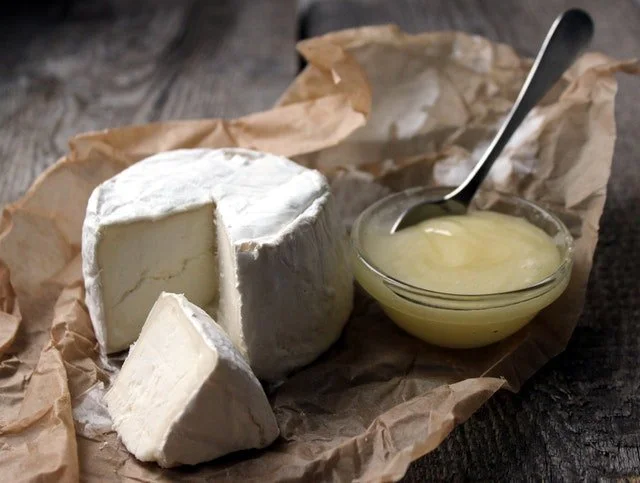How do You Make Cheese?
Ever Wondered How to Make Cheese?

We answer that question today...
Today I thought we'd talk a bit about the oh so important question of how to make cheese. Okay, I know, you may not think it's a very important question, but considering that in 2016 the average American consumed about 38.5 pounds of cheese, it's probably interesting at least.
What is Cheese?
 First off let's discuss what cheese actually is. At its most basic level, cheese really is just preserved milk. Folklore says, cheese was originally discovered by an Arabian merchant who stored milk in a sheep's stomach during his trek across the hot dessert. The natural rennet in the lining of the sheep's stomach, combined with the heat of the day, separated the milk into curd and whey.Since then, we've become much more refined in our cheese making practices. In fact, there are companies out there with millions of dollars invested in the creation and protection of proprietary cultures and enzymes (the use of which we'll discuss later)!It's kind of amazing to think that food found accidentally by a humble nomad now commands an industry worth over $57 million in 2018. I think I'll start hiking with various perishable foods, just to see what happens...
First off let's discuss what cheese actually is. At its most basic level, cheese really is just preserved milk. Folklore says, cheese was originally discovered by an Arabian merchant who stored milk in a sheep's stomach during his trek across the hot dessert. The natural rennet in the lining of the sheep's stomach, combined with the heat of the day, separated the milk into curd and whey.Since then, we've become much more refined in our cheese making practices. In fact, there are companies out there with millions of dollars invested in the creation and protection of proprietary cultures and enzymes (the use of which we'll discuss later)!It's kind of amazing to think that food found accidentally by a humble nomad now commands an industry worth over $57 million in 2018. I think I'll start hiking with various perishable foods, just to see what happens...
How to Make Cheese
Step 1: Milk
 First things first, if you want to make cheese, you need milk.Side note: For the sake of argument, I'm not going to include vegan style cheeses made from nuts like cashews. So just put that aside, or else incur the wrath of Wisconsin. Like most foods, quality in = quality out. Great cheese requires great milk produced by happy cows. Happy cattle are kept that why by being free to graze generously on natural pastures, are not treated with hormones like rBST, and are provided shelter from severe weather.Milk quality is also determined by how far it must travel (the rocking motions during transportation can cause the build up of lactic acid which creates off flavors) and how long it takes to begin the process of becoming cheese.
First things first, if you want to make cheese, you need milk.Side note: For the sake of argument, I'm not going to include vegan style cheeses made from nuts like cashews. So just put that aside, or else incur the wrath of Wisconsin. Like most foods, quality in = quality out. Great cheese requires great milk produced by happy cows. Happy cattle are kept that why by being free to graze generously on natural pastures, are not treated with hormones like rBST, and are provided shelter from severe weather.Milk quality is also determined by how far it must travel (the rocking motions during transportation can cause the build up of lactic acid which creates off flavors) and how long it takes to begin the process of becoming cheese.
Step 2: Pasteurization
 Pasteurization is the process of rapidly heating and cooling product to destroy bacteria, increase shelf-life, and protect consumers. The faster the milk reaches it's pasteurization temperature and the faster it is cooled back down the better flavor it will impart.
Pasteurization is the process of rapidly heating and cooling product to destroy bacteria, increase shelf-life, and protect consumers. The faster the milk reaches it's pasteurization temperature and the faster it is cooled back down the better flavor it will impart.
Not all cheeses are pasteurized, mind you, but the majority are. Some local grocers and farmers markets will sell raw milk cheese, but their ability to is controlled on a state by state level. For more information about these regulations, check the FDA website.
Step 3: Add Cultures

Photo Courtesy of Cashewbert.com
Now that our milk is safe, we're going to gently warm it up to a given temperature (usually between 77-100*F), then add our starter. The starter begins to acidify the milk, converting sugar into lactic acid, and once the pH gets low enough the milk will coagulate (solidify).As the milk coagulates it separates into curd (solid) and whey (liquid). This is what our humble adventurer of the dessert created in his sheep stomach milk container. The cultures also begin to form the initial flavor and texture profile for the cheese.NOTE: There are many different cheeses made many different ways, we're outlining the most common method for basic understanding.
Step 4: Add Enzymes

Photo Courtesy of OldWorldGardenFarms.com
This step may or may not occur, depending on the cheese being made.The most common enzyme added to cheese is rennet, which is found naturally in the stomach of certain mammals (hello adventurer!). The rennet used in modern cheese making actually comes from vegetable sources like fig leaves, melons, or fermented mushroom bacteria.Rennet is an enzyme that assist in the coagulation of the cheese, making it denser and increasing yield. Some softer cheeses skip this step.The enzyme used in this step will provide the most impact on the final flavor and texture of the cheese.
Step 5: Separate

Image Courtesy of CheeseMaking.com
Alright, now that we have or curds and whey all divided, we need to separate them.Whey is drained off and used for other purposes, like acting as a brine for fresh mozzarella cheeses, making ricotta, or being refined into powder for protein supplements.The remaining curd is now ready for its close up. Dependent on the final product, the curd will be cut into a desired size (smaller curd = less moisture). It's at this point the cheese is salted, which flavors the cheese, slows down enzymatic activity, and protects it from harmful bacteria.
Step 6: Pressing & Forming
Image Courtesy of UEN.org
With the curds prepared, it's time to shape and press the cheese.The shape selected is dependent on the cheese type and use. Wheels and blocks are very common, but other shapes are made also.During the forming, the cheese is also pressed to remove additional moisture. Moisture promotes bacterial growth, and while bacteria is essential to the cheese making process, it's important to grow good bacteria and eliminate bad. Therefore, softer cheeses are usually aged less.The removal of moisture also plays into the final taste and texture of the cheese. A higher moisture cheese (brie, Camembert), will have a soft texture, good for spreading, and often a light cream flavor. A low moisture cheese (Parmesan, Asiago), will have a concentrated, powerful flavor, and hard texture, good for grated and shaving.There are many levels of moisture in cheeses, but that's a conversation for another time.
Step 7: Aging
 The seventh, and final step in the cheese making process is aging. Our cheese is seasoned, formed, and pressed, so now it needs some time to kick back and relax.The aging stage is vital in the formation of flavor. Cheeses are aged in a temperature, humidity, and light controlled environment. During this time the rind of the cheese develops. As a rule of thumb, the longer the aging the more intense the cheese flavor.Some cheeses can be very intense without long aging periods due to the type of mold utilized in their making. Examples are Gorgonzola and Humboldt Fog.
The seventh, and final step in the cheese making process is aging. Our cheese is seasoned, formed, and pressed, so now it needs some time to kick back and relax.The aging stage is vital in the formation of flavor. Cheeses are aged in a temperature, humidity, and light controlled environment. During this time the rind of the cheese develops. As a rule of thumb, the longer the aging the more intense the cheese flavor.Some cheeses can be very intense without long aging periods due to the type of mold utilized in their making. Examples are Gorgonzola and Humboldt Fog.
Closing
That's it for our discussion on how to make cheese. I had fun writing it and I hope you had fun reading along.Until next time, cheers!

